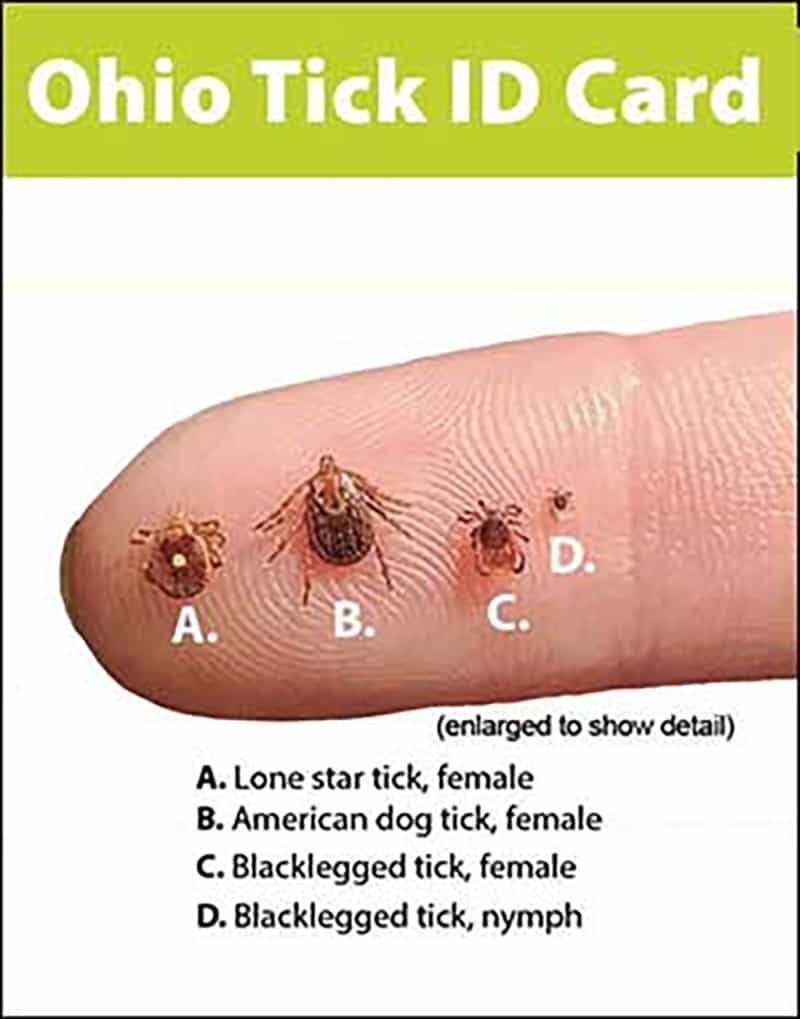330-476-6343 | [email protected]

330-476-6343 | [email protected]

Health officials encourage residents to protect themselves from ticks
CCM Staff Report
The number of cases of Lyme disease in Ohio and Carroll County has increased significantly over the last 10 years.
According to the Ohio Department of Health, in 2010, 44 cases of human Lyme disease were reported. In 2019, that number jumped to 468. From 2018 to 2019, cases increased from 293-468.
In comparison, Carroll County reported 35 confirmed cases in 2019, 51 in 2020, and 14 to date in 2021.
In Ohio, cases of Lyme disease are reported in every month of the year. However, the number of reported cases is lowest in the winter, gradually rises in the spring, peaks in the summer, then declines through late summer and autumn.
Ohio has three medically important species of ticks: the American dog tick, blacklegged tick, and lone star tick. All three of these species have the potential to carry and transmit diseases to humans and pets. The American dog tick is the most common tick in Ohio and is found in grassy areas. This tick is most active during the summer months and is the primary transmitter of Rocky Mountain spotted fever.
Blacklegged tick populations have increased in Ohio since 2010, particularly in areas with forested habitat. This species can carry Lyme disease and is active throughout the year, including during the winter. Also known as the deer tick, blacklegged ticks are frequently found on white-tailed deer.
The lone star tick is found mostly in southern Ohio and can transmit several diseases. It is found in shaded, grassy areas and is active during the warmer months of the year.
“Ticks have the ability to transmit diseases to humans in 36 to 48 hours after the initial bite,” said Ohio Wildlife Council President and retired veterinarian Dr. Paul Mechling. “Urban and suburban development as well as outdoor recreation allows the spread of these diseases as people come in close contact with mice, white-tailed deer, and other hosts for ticks. Pets in an outdoor setting should have tick control.”
“Ohioans are at greatest risk for contracting tick-borne disease from June through August, but Lyme disease is possible year-round,” says Dr. Glen Needham, associate professor emeritus of Entomology at The Ohio State University. “Wear proper clothing and use repellent to help prevent tick attachment.”
The Ohio Department of Natural Resources says when exploring the outdoors, precautions should be taken to prevent ticks from becoming attached to the skin. Outer clothing should be sprayed with permethrin-based repellent according to the label directions. Pants should be tucked into socks or boots and shirts into pants to keep ticks on the outside of the clothing. Wear light colored clothing which will make spotting ticks easier. Thoroughly check clothes and skin for any attached ticks. Don’t forget to check pets and gear, too.
Check for ticks after being outdoors, even in your own back yard. Conduct a body check upon arrival from potentially tick-infected areas by searching your entire body for ticks. Take extra precautions during the spring, summer and fall when ticks are most active, checking in and around the hair and ears, under the arms, inside the belly button, around the waist, between the legs, and the back of the knees. Check pets in and around the ears, around the eyelids, under the collar, under the front legs, between the back legs, between the toes, and around the tail. Use a handheld full-length mirror to view all parts of your body and remove any tick you find.
If you develop a rash or fever within several weeks of removing a tick, see your doctor. Be sure to tell your doctor about your recent tick bite, when the bite occurred, and where you most likely acquired the tick.
An unexpected summer fever or odd rash may be the first signs of tick-borne disease, particularly if a person has been in a tick habitat. See a health care provider if these symptoms develop.
Prevent family pets from bringing ticks into the house by limiting their access to tick-infested areas and by using veterinarian-prescribed tick collars or spot-on treatment.
Create Tick-Safe Zones in the yard. Keep patios, play areas, and playground equipment away from shrubs, bushes, and other vegetation. Regularly move leaf litter, clear tall grasses and brush around homes and place wood chips or gravel between lawns and wooded areas to keep ticks away from recreational areas.
Use a chemical control agent. Effective tick control chemicals are available from use by the homeowner, or they can be applied by a professional pest control expert.
Discourage deer. Deer are the main food source for adult ticks. Keep deer away from homes by removing plants that attract deer and by constructing physical barriers that may discourage deer from entering your yard and bringing ticks with them.
A vaccine for Lyme disease is not currently available.
More information is available at the Ohio Department of Health website at http://ohio.gov/tick., Centers for Disease Control and Prevention atwww.cdc.ov/Lyme or by contacting the Carroll County General Health District at 330-627-4866, ext. 1522 or 1562, or visit the website at www.carroll-lhd.org.
Interested in a monthl roundup of stories? Enter your email to be added to our mailing list.
